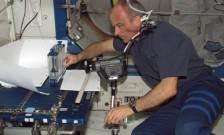Mission Discovery experiments

Science experiments designed by pupils from the Mission Discovery Programme held at King's College London in 2013 and 2014 have been launched into space from Cape Canaveral Air Force Station in Florida, on a journey to the International Space Station.
This is the second time experiments designed by schoolchildren are being sent into space to be carried out by astronauts aboard the International Space Station. This year, pupils from the Mission Discovery Programme worked together in teams to design various scientific experiments. The three winning experiments alongside two others from Mission Discovery events held in Renfrewshire and at the Embry Riddle Aeronautical University (USA) were chosen to be flown into space. The experiments are being conducted on the International Space Station by astronaut Jeff Williams
The Mission Discovery Programme is run by the International Space School Educational Trust (ISSET) and the Centre of Human & Aerospace Physiological Sciences (CHAPS) at King's and involves NASA astronauts Ken Ham and Michael Foale. The experiments were overseen in their development by Dr Julie Keeble who also supervised the final stages of pre-flight preparation at the Kennedy Space Centre.
Professor Stephen Harridge, Director of CHAPS said: 'Not many career scientists get to have their experiments undertaken in space, so this is an amazing opportunity for these children to have their ideas come to fruition in this way. Dr Julie Keeble deserves particular credit for overseeing the whole process and enabling the ideas honed in an intensive Mission Discovery week at King's to become a scientific reality aboard the ISS.'
The three experiments from King's are:
- Daphnia magna in space: Daphnia will produce sexually or asexually depending on the nature of their environment. Under stressful conditions, they will resort to sexual reproduction. The aim of this study is to determine whether the microgravity environment of the ISS is stressful enough to initiate sexual reproductive activity through analysis of eggs.
- Effect of plant steroids on plant growth in microgravity: Plants are notoriously difficult to grow in microgravity, but they will provide an essential food source for long-term space missions. This experiment will determine whether plant steroids can potentiate their growth in a microgravity environment.
- Saprophytic degradation of food in space: Saprophytes (including many types of yeast) are capable of degrading food substances. As food waste is a potential problem for long term space missions, this experiment will determine whether the saprophyte, Kazachstania telluris, can degrade food in microgravity.
More information: For further information please visit the Mission Discovery website: isset.org/mission_discovery/
Provided by King's College London





















